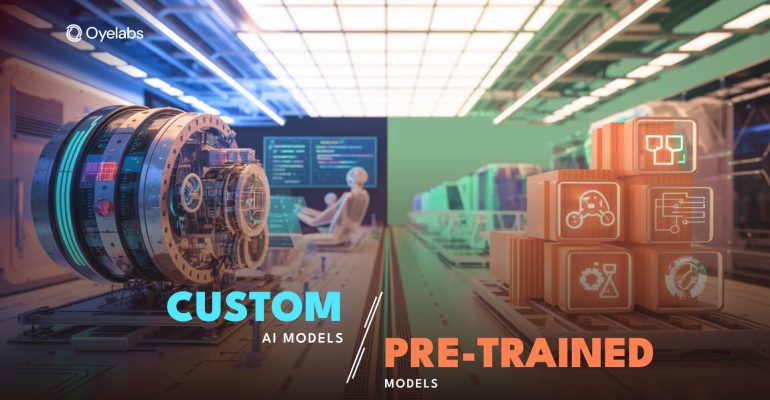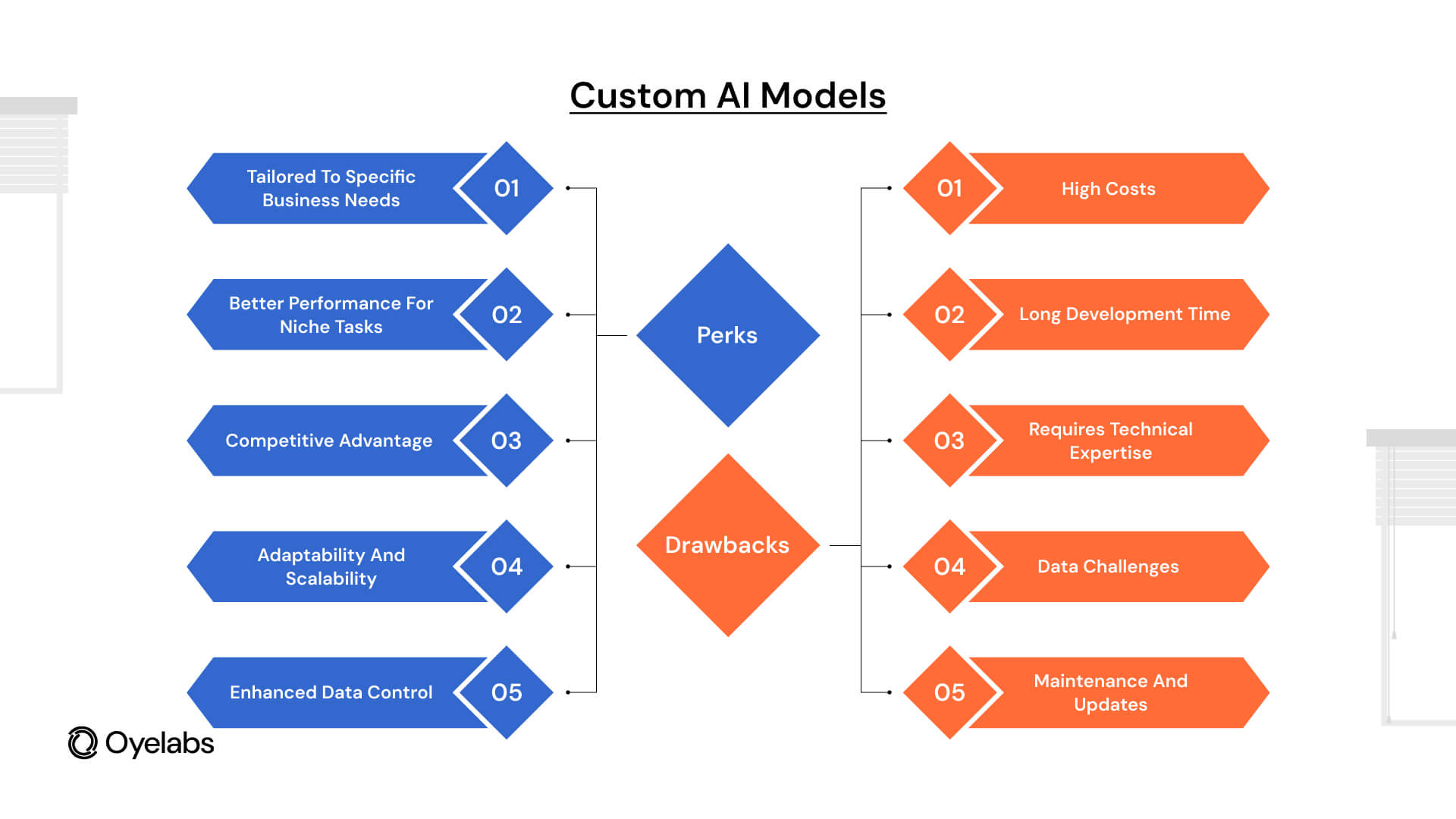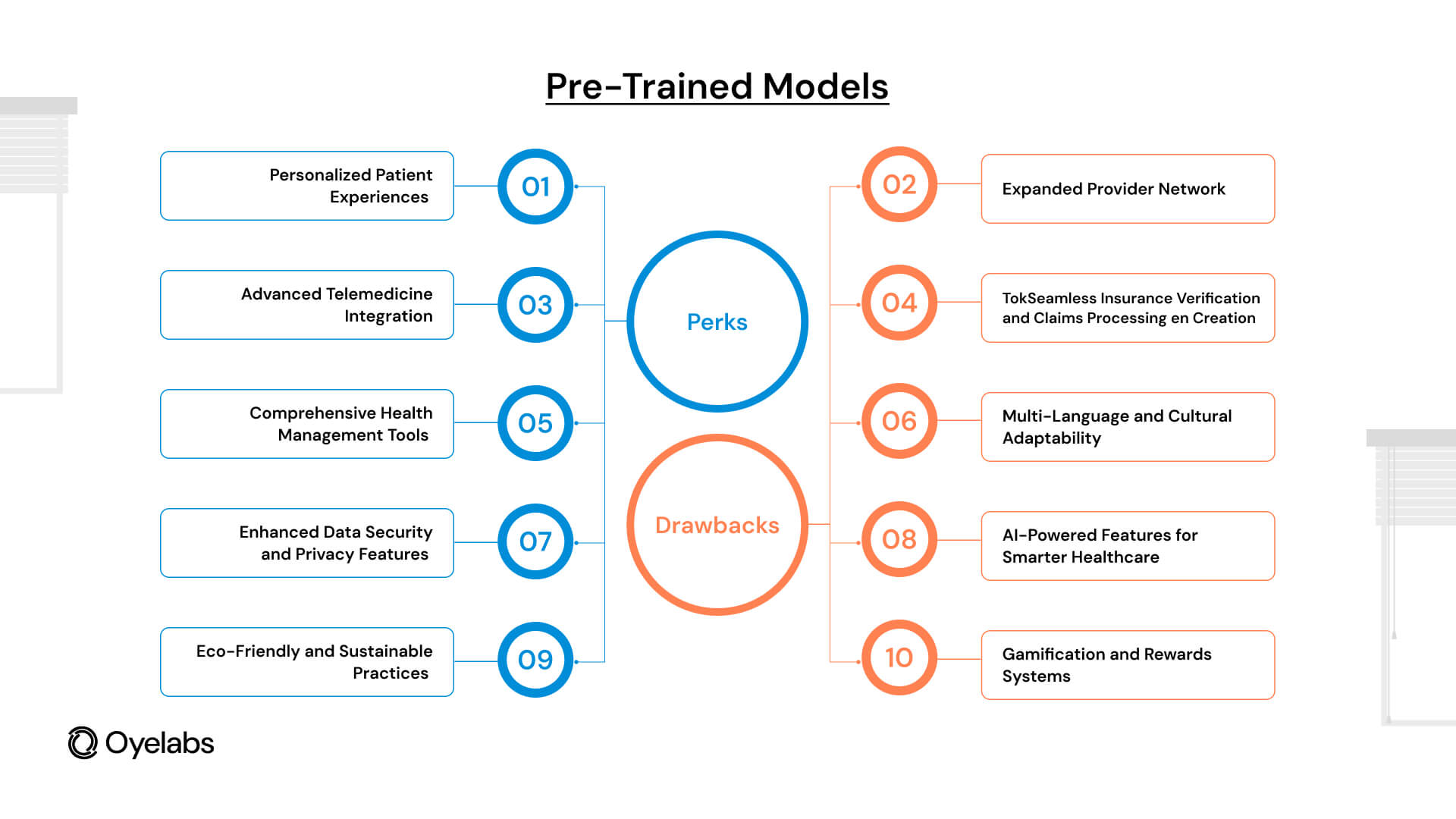Custom AI Models VS Pre-trained Models: Make the Best Choice

Custom AI Models VS Pre-trained Models: Make the Best Choice
Last Updated on February 5, 2025
Deciding between custom AI models and pre-trained models is a common challenge for businesses exploring artificial intelligence. Should you invest in a custom AI solution designed specifically for your needs, or opt for a pre-trained model that offers speed and cost savings? It’s a tough choice, but one worth making carefully.
Recent studies indicate that over 80% of enterprises view AI and machine learning as key technologies for achieving business goals.
Additionally, 73% of data and analytics decision-makers are building AI technologies, with 74% observing a positive impact from these technologies in their organizations.
Custom models shine in precision and adaptability, while pre-trained ones often excel in accessibility and proven effectiveness. In this blog, we’ll explore the benefits, limitations, and ideal use cases for each, providing clear insights to help you make the smartest decision for your business’s AI journey.
Overview of Custom and Pre-trained Models
Custom AI Models
Custom AI models are designed and developed to solve very specific problems within a business. These models are trained on proprietary data, ensuring they are optimized for the company’s individual needs. Custom models require careful planning, from defining objectives to selecting and preparing data and training the model on unique datasets. The output is a solution designed to provide maximum efficiency and effectiveness for the organization’s specific business context.
Characteristics:
- Tailored Solutions: Custom AI models are built with specific business requirements in mind. For example, a retail business might develop a custom AI model for demand forecasting based on its historical sales data, while a healthcare provider might build a model to analyze patient records for predictive diagnosis.
- Data Dependency: The quality and quantity of data available are crucial for training custom models. Organizations need access to clean, well-labeled, and relevant data to achieve optimal performance.
- Flexibility: Custom AI models are highly adaptable. As business needs evolve or new data becomes available, the model can be retrained, modified, or expanded to meet these changes.
Pre-trained Models
Pre-trained models, in contrast, are models that have already been trained on large datasets and are available for use without the need for further training. These models are typically general-purpose, designed to perform a wide range of tasks such as natural language processing (NLP), image recognition, or recommendation systems. Major AI companies like Google, Microsoft, and OpenAI offer pre-trained models, which are ready to be deployed out of the box for general business applications.
Characteristics:
- Quick Implementation: Pre-trained models save time since they are already trained and ready for use. Businesses can implement these models with minimal setup and configuration, often within a matter of hours or days.
- General-purpose: These models are built on large, diverse datasets, meaning they can solve general problems but are less optimized for highly specialized tasks.
- Less Data Intensive: Unlike custom models, pre-trained models do not require businesses to provide large datasets. They leverage the knowledge embedded in the models, which is built from general, publicly available data.
Perks and Drawbacks of Custom AI Models
Perks:
Tailored to Specific Business Needs
Custom AI models are specifically designed to address the unique needs and challenges of a particular business. Unlike generic, pre-trained models, which are trained on a broad range of data, custom models are built to solve a company’s particular problems, making them more effective in those situations. For example, a custom AI model used by a bank can focus on identifying fraud based on the institution’s own transaction data, which is far more effective than relying on a pre-trained model designed to work with general transaction patterns. This tailored approach maximizes the potential of AI to bring real value to the business.
Better Performance for Niche Tasks
Custom AI models are built with a deep understanding of industry-specific data, which makes them highly efficient at solving niche or specialized tasks. Businesses that require AI to process complex scenarios with a lot of domain-specific knowledge—like healthcare, finance, or pharmaceuticals—can benefit from custom models trained with their data. For instance, a pharmaceutical company may develop a model to predict drug interactions based on proprietary medical data. This specialized model would outperform a general AI system that is trained on more generic datasets, allowing the company to gain better insights and improve decision-making.
Competitive Advantage
By developing a custom AI model, businesses can create products or services that offer distinct advantages in the marketplace. This differentiation can give them a significant edge over competitors. Custom AI allows businesses to craft solutions that are tailored to their exact business strategies and target audiences, providing customers with experiences they can’t find elsewhere. For example, a custom recommendation system for an e-commerce platform can offer hyper-personalized shopping experiences, encouraging customer loyalty and increasing sales. Competitors who rely on generic AI solutions may not be able to replicate this level of customization.
Adaptability and Scalability
A key benefit of custom AI models is their adaptability. Businesses that experience growth or face shifting market conditions can continuously retrain and adjust their custom AI models. In fact, Gartner predicts that by 2025, 75% of enterprises will use AI to automate at least 50% of their IT operations, highlighting how scalable, adaptable models will become essential for growing businesses. Custom models can scale alongside a company’s expansion, whether it’s launching new products or entering new regions, ensuring that AI continues to deliver valuable insights as the business evolves.
Enhanced Data Control
With a custom AI model, businesses maintain full control over their data. This is crucial for industries with strict data privacy requirements, such as healthcare and finance. A Deloitte report notes that 45% of businesses consider AI governance, including data privacy, a top priority, which is made easier with custom models. Businesses can ensure that data is handled securely, comply with regulations such as GDPR or HIPAA, and maintain customer trust by using their data in a controlled, transparent way. This level of control can significantly reduce risks related to data breaches, which cost companies an average of $5.17 million per breach according to IBM.
Drawbacks
High Costs
One of the biggest challenges of custom AI models is the cost. Developing a custom AI solution requires significant financial investment in various aspects, including data collection, model design, and training. The process of developing and fine-tuning a custom model is expensive and resource-intensive. For smaller businesses, these costs can be prohibitive, especially when the return on investment may take some time to materialize. Additionally, maintaining and updating the model over time requires continuous resources, which can add up to substantial ongoing expenses.
Long Development Time
Custom AI models take time to develop. The process involves collecting and cleaning large datasets, selecting appropriate algorithms, and training the model to ensure it delivers accurate results. This lengthy development timeline can delay the business’s ability to launch or benefit from AI-powered solutions. Depending on the complexity of the model and the amount of data, the development process can stretch from weeks to months. For businesses needing quick AI solutions, this extended timeline can be a significant disadvantage, especially if the business is working within tight deadlines.
Requires Technical Expertise
Building a custom AI model is not a simple task. It requires specialized knowledge in fields like AI, machine learning, and data science. Businesses that do not have in-house technical experts may need to hire a team or collaborate with external consultants, which adds to the cost and complexity of the project. The need for highly skilled professionals in these areas also means that custom AI solutions require a strong technical foundation within the organization, which can be a barrier for smaller businesses or those with limited resources.
Data Challenges
The effectiveness of a custom AI model is directly tied to the quality of the data it is trained on. Gathering and preparing high-quality, labeled data can be a significant challenge. Businesses need to invest in comprehensive data collection and cleaning processes to ensure that the datasets used are accurate, relevant, and free from errors. Poor-quality data can lead to inaccurate or biased models, which in turn impacts the performance of the AI. Additionally, obtaining and maintaining relevant datasets can be both time-consuming and costly, particularly for businesses in niche industries.
Maintenance and Updates
Once a custom AI model is deployed, it requires continuous maintenance and updates to remain effective. As new data becomes available or the business environment changes, the model needs to be retrained and adjusted to accommodate these changes. This ongoing process requires resources and expertise to ensure the model continues to deliver accurate results. Without regular updates, the model may become obsolete or less effective over time, which means the business must dedicate resources to maintain its performance. This long-term commitment can be a burden for companies with limited capacity.
Perks and Drawbacks of Pre-Trained Models
Perks
Cost-Effective Solution
Pre-trained models are much more cost-effective compared to custom-built solutions. Since these models are already developed and optimized for general tasks, businesses can skip the expensive and time-consuming development process. Instead, they can simply implement these models, saving costs related to data collection, model training, and infrastructure. For smaller businesses or those with budget constraints, pre-trained models offer an affordable way to leverage AI without the need for significant financial investment.
Fast Implementation
Pre-trained models are ready to deploy immediately, which significantly reduces time-to-market. Since these models have already been trained and optimized, businesses can integrate them into their systems within hours or days, depending on the complexity of the implementation. This fast implementation is crucial for businesses with urgent AI needs or those trying to quickly launch new products or services. With pre-trained models, businesses can start seeing the benefits of AI almost immediately, which is especially valuable in fast-moving industries.
Minimal Resource Requirements
One of the biggest advantages of pre-trained models is that they require very few resources to deploy. Unlike custom models, which demand a significant investment in AI infrastructure and expertise, pre-trained models can be used with minimal technical resources. Businesses do not need to build or maintain an AI infrastructure, nor do they need to hire data scientists or machine learning experts. This makes pre-trained models a viable option for organizations without in-house AI expertise or those with limited technical capacity.
Proven Effectiveness
Pre-trained models, especially those developed by established providers, have typically been tested across a wide range of applications. They have proven their effectiveness in solving general problems like text classification, sentiment analysis, or image recognition. These models have been refined through extensive use in real-world scenarios, making them reliable for tasks that do not require niche knowledge. For businesses with broad AI needs, these pre-trained models are a trusted and effective solution, offering solid performance in a variety of industries.
Easier Maintenance
Since pre-trained models are developed and maintained by third-party vendors, businesses don’t have to worry about updates, bug fixes, or improvements. The responsibility for ensuring that the model remains current and performs effectively lies with the vendor. This significantly reduces the maintenance burden for businesses, as they don’t need to invest time or resources into keeping the model up to date. This hands-off maintenance can be particularly beneficial for businesses with limited IT resources or those seeking a low-maintenance AI solution.
Drawbacks
Limited Customization
Pre-trained models are designed to be general-purpose, which means they are not easily customizable to meet the specific needs of a business. While they may work well for standard tasks, they often struggle when it comes to specialized requirements or industry-specific applications. Businesses may find that the model’s performance is suboptimal for tasks that require deep domain expertise, and they may not be able to adjust the model’s behavior to suit their unique use cases.
Lower Accuracy for Niche Tasks
Since pre-trained models are trained on broad, general datasets, they are not always accurate for specialized tasks that involve niche data. For example, a pre-trained model for sentiment analysis may not understand the nuances of industry-specific jargon or context. This lower level of accuracy can be a major drawback for businesses that need to solve specific or complex problems. In these cases, businesses may find custom models to be a better fit, as they can be trained on more relevant and specialized data.
Limited Flexibility
Pre-trained models come with limited flexibility. Businesses do not have the ability to modify the model’s architecture, algorithms, or training process. This lack of control can be a disadvantage when businesses need to adapt the model to new requirements or changes in their market. If a pre-trained model doesn’t meet the company’s needs or fails to perform well as market conditions evolve, there is little the business can do to adjust it. This inflexibility may limit its long-term value.
Reliance on External Providers
Using pre-trained models means businesses depend on external vendors for ongoing support, updates, and improvements. This reliance can create risks, particularly around data privacy, security, and the continuity of service. If the vendor experiences issues such as a change in business priorities or failure to provide timely updates, it could leave the business without the necessary resources to maintain or improve the model. This dependency also means businesses may have limited control over the direction of the model’s development.
Limited Long-Term Scalability
Pre-trained models may not be able to scale effectively as businesses grow. As companies expand or their needs change, pre-trained models may struggle to keep up with evolving requirements. While these models may work well in the short term, they might not be as adaptable or efficient for businesses looking for long-term, scalable solutions. As a result, companies might eventually need to transition to custom models, which could involve significant additional costs and resources.
Also Read: Guide to build an AI App
Pre-Trained vs. Custom AI Models
| Feature | Custom AI Models | Pre-trained Models |
| Customization | Highly tailored to specific business needs | Limited to general-purpose functionality |
| Development Time | Longer, requiring significant data collection | Quick, ready for immediate use |
| Cost | High, due to data gathering and development | Low, as no new model development is required |
| Performance | High for niche, domain-specific tasks | Effective for general tasks but less accurate for specific ones |
| Flexibility | Full control, can be adjusted as needed | Minimal control over the model’s internals |
| Data Requirements | Requires proprietary data for training | No need for proprietary data, works with general datasets |
Select the Right Custom or Pre-Trained AI Models
Choosing between custom and pre-trained AI models is a decision that depends on various factors, such as the nature of the task, business objectives, and available resources. Here are some critical considerations when deciding which approach to take:
- Business Needs and Use Case:
- For highly specific tasks that require deep expertise, custom models are ideal. For instance, an AI-driven fraud detection system tailored for a specific business would benefit more from a custom model.
- Pre-trained models are more suitable for general-use tasks like sentiment analysis or image classification, where the business does not require deep customization.
- Budget Constraints:
- Pre-trained models are an excellent choice for businesses working with limited budgets or those who need to deploy AI solutions quickly.
- Custom models are more expensive but may deliver a higher return on investment in the long term if they provide a tailored solution that addresses critical business needs.
- Development Timeline:
- Pre-trained models can be deployed much faster, making them ideal for businesses that need a solution quickly.
- Custom models take longer to develop but may be necessary if a business requires a solution that is highly specific to its operations.
- Data Availability and Quality:
- Custom models require high-quality, business-specific data. If a company has access to rich data, a custom model might yield better results.
- Pre-trained models work well when a business does not have the necessary data for training a custom model but still wants to leverage AI capabilities.
- Long-Term Scalability and Maintenance:
- Custom models are easier to scale and adapt as the business grows and evolves. They can be retrained and modified to meet new demands.
- Pre-trained models, while easy to implement, may require third-party updates and lack the flexibility to scale as rapidly.
With a team of skilled professionals, we deliver scalable and cost-effective AI solutions that are tailored to help you achieve your objectives. Our commitment to innovation and client satisfaction has positioned us as a trusted partner for businesses looking to harness the power of AI technologies.
Conclusion
In the debate between custom AI models and pre-trained models, there is no one-size-fits-all solution. The right choice depends on your business needs, budget, timeline, and expertise. While custom models offer tailored solutions for unique business challenges, pre-trained models provide an accessible and cost-effective option for those looking for quicker results. Understanding the differences between these two options is crucial to making an informed decision that aligns with your business objectives.
When in doubt, consulting with an expert AI development partner like Oyelabs can help guide your decision-making process and ensure the successful implementation of AI in your organization.
Also Read





